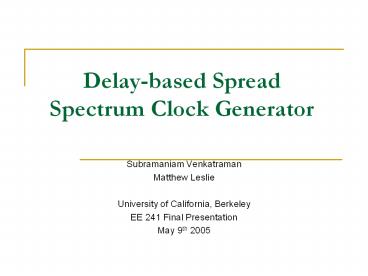Delaybased Spread Spectrum Clock Generator - PowerPoint PPT Presentation
1 / 11
Title:
Delaybased Spread Spectrum Clock Generator
Description:
Result: Edge-to-edge jitter varied in deterministic fashion. Digital Delay Array Element ... Improved Design ... Latch based design provides reduced rise and ... – PowerPoint PPT presentation
Number of Views:123
Avg rating:3.0/5.0
Title: Delaybased Spread Spectrum Clock Generator
1
Delay-based Spread Spectrum Clock Generator
- Subramaniam Venkatraman
- Matthew Leslie
- University of California, Berkeley
- EE 241 Final Presentation
- May 9th 2005
2
Motivation
- In digital systems, the most amount of
electromagnetic interference (EMI) is caused by
the high-speed digital clock - Strict FCC regulations on maximal permitted EMI
- Traditional solutions shielding the chip,
filtering the clock signal - Solution Spread the spectrum of the clock over a
small frequency range within the timing margin
(usually /- 1) so peak emission is attenuated - Often accomplished by modulating the frequency of
the VCO in a PLL
Keith B. Hardin, Spread Spectrum Clock
Generation for the Reduction of Radiated
Emissions
3
Delay Cell Array Based Approach
- SSCG usually implemented with 50KHz modulation
waveform to prevent interference with FM systems - PLL is required to have a large loop bandwidth
hence making it more susceptible to noise - Leads to large jitter in clock which is
unacceptable - Instead can be implemented with a variable delay
elements which introduce appropriate delays and
shift the effective frequency - Leads to smaller random jitter, simpler
implementation and reduction in area - The idea has been reported but uses 200 delay
stages and shows unnatural clock waveform with
maximum energy in the 4th harmonic - 0.35µ CMOS technology used to compare with
reported results from Jonghoon Kim et al.
4
Digital Delay Array
- Each delay cell comprised of delay element and a
positive latch
Delay Cell 1
Delay Cell 2
Delay Cell N
Result Edge-to-edge jitter varied in
deterministic fashion.
5
Digital Delay Array Element
- Characteristics
- Delay varies linearly with Lx.
- All elements have identical off delay.
- Keeps tpLH and tpHL the same.
- Identical fanout independent of delay
6
Comparison of Clock Attenuation
- Reported results show
- Large power in even clock harmonics
- Percentage spread not constant with frequency
- Our results show
- Dominant power in odd harmonics
- Percentage spread constant with frequency
Jonghoon Kim 2004 IEEE international symposium
on electromagnetic compatibility
7
Improved Design
- For a 1GHz system with 50KHz modulating waveform,
number of stages in earlier design would be
20,000 - Removes the direct dependency of number of stages
on the ratio between clock frequency and
modulation frequency which is major limiting
factor in previous design - Triangular modulation waveform applied to delay
elements would lead to clock pulses with equal
period and therefore constant frequency - Create modulation waveform needed by integrating
the triangular wave - Use this modified waveform to control the current
through a current-starved differential delay
element - Non linearity in improved design can be corrected
by changing input waveform
8
Improved Design
- Jitter is dictated by two characteristics of the
delay element - the power supply rejection ratio (PSRR),
represented by the numerator - the maximum slope at the switching-point of each
delay element, represented by the denominator. - Differential stage provides high PSRR
- Latch based design provides reduced rise and fall
time
9
Comparison with MATLAB Results
- Triangular modulation causes non ideal frequency
spread but the error caused is 1.7dB and
simplifies implementation - Our implementation shows greater spread than
designed for due to non-linearity of analog delay
element
10
Comparison of Results
11
Conclusions Future Work
- Delay cell based SSCG implemented shows low power
and simple circuit implementation - 8dB of clock attenuation on fundamental
- Approach requires constant number of delay stages
with increasing clock frequency unlike previous
reported result - Modulation frequency not hard-coded in the
circuit - The linearity of the delay stage needs to be
improved either using circuit techniques or by
compensating initial input signal - Jitter can be reduced by trading off with number
of stages - An actual implementation would be needed to test
for actual jitter caused and clock attenuation
achieved































